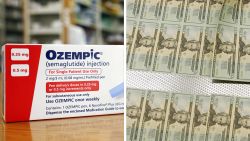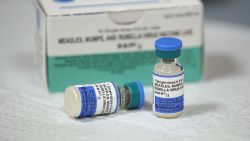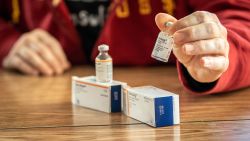Editor’s Note: Dr. Tom Frieden, director of the US Centers for Disease Control and Prevention during the Obama administration, when he oversaw responses to the H1N1 influenza, Ebola and Zika epidemics, is President and CEO of Resolve to Save Lives, an initiative of Vital Strategies and Senior Fellow for Global Health at the Council on Foreign Relations. Twitter: @DrTomFrieden.
An article published recently in the New England Journal of Medicine reports some astounding research findings which could save millions of lives. Why did you miss it? Because there was zero media coverage (apart from a few specialty medical blogs). Zero. That tells you something. Tells you a lot, actually. So, here are the details.
High blood pressure is the world’s leading killer – and will kill more people, including more young people, than Covid-19 (and, in usual years, more than all other infectious diseases combined). High blood pressure can be prevented, mostly by reducing dietary sodium, and is effectively treated with safe, low-cost medications.

But globally, we’re doing terribly on blood pressure control. Less than 1 in 7 people with high blood pressure, an abysmal 14%, have it controlled. This is, frankly, pathetic – and is killing millions of people a year. It’s the most important health care intervention for adults to save lives, and we get it right less than 1 in 7 times (and, in the United States, with a $4 trillion dollar health care system, we get this right less than half the time, despite it being the intervention that can save more lives than any other health care intervention in the US!)

Elegant studies by University of Oxford scientists prove that, for every 20-point increase in systolic blood pressure (the larger “top” number), the death rate from cardiovascular disease doubles. What’s more, this starts at a blood pressure of 115/75 – way below the usual level at which we treat, or toward which we aim treatment.

But showing that lower is better didn’t prove that lowering more is better. That’s where the incredibly important Systolic Blood Pressure Intervention Trial (SPRINT) study, begun in 2010, comes in. It’s one thing to prove (as Oxford’s Dr. Sarah Lewington did) that lower blood pressure correlates with lower risk of death, but quite another to prove that lowering blood pressure more saves more lives.
Lower blood pressure reduces the risk of death, but how low do we need to go? That’s what’s big news about the results from the SPRINT study that were just released. They prove that lower IS better – and that setting a blood pressure goal lower than the standard treatment goal prevented many more deaths.
The SPRINT study also showed that, despite more side effects (far less dangerous than heart attack or stroke), intensive blood pressure treatment to reach the lower blood pressure goal is safe – even for older people. More intensive treatment prevented more heart attacks, strokes and deaths.
Based on the SPRINT study, many guidelines now recommend that certain high-risk patients with high blood pressure aim for a systolic blood pressure below 130 rather than the standard target of 140. (SPRINT aimed for an even lower target of 120/80.)

But the bigger implication: We need to do much better at getting people to under 140/90. For years, doctors were afraid to lower their patients’ blood pressures to levels they thought would be too low, and potentially dangerous. Now, it’s proven that “overshooting” the goal of 140/90 isn’t just something that won’t hurt the patient – it could well save their life.
The death rate among people treated with a blood pressure goal of under 120/80 was 27% lower than the death rate of people treated to the usual target of 140/90. And for every death prevented, about two heart attacks are prevented in addition to strokes, kidney failure, dementia, and more.
Now, it’s also true that interventions other than medication can be important. Reducing sodium, in particular, can reduce blood pressure and other health harms from our overly salty diet. Getting regular physical activity, eating a healthier diet overall, reducing air pollution, and more can make a big difference. But these interventions are best done on a societal, community-wide basis.
That’s why, although we should empower and inform patients, we shouldn’t expect them to be able to withstand the obesogenic, salty, sedentary, polluted environment we live in. And even if we could magically improve our food and overall environment, there would still be a billion people in the world in need of medications to treat their hypertension.
Why are we failing to control high blood pressure? One reason is that we’ve made treatment too complicated – far more complicated than it needs to be for optimal results. For the past four years, Resolve to Save Lives has worked with our global partners to identify characteristics of high-performing hypertension control programs throughout the world; we summarized lessons learned in this article and in this graphic.
Get CNN Health's weekly newsletter
Sign up here to get The Results Are In with Dr. Sanjay Gupta every Tuesday from the CNN Health team.
The WHO HEARTS technical package for improving cardiovascular health simplifies hypertension treatment: standard treatment protocols that any health worker can implement, reliable supply of quality-assured medicines, team-based health care, patient-centered services and a strong health information system. This makes it more likely that patients will achieve and maintain blood pressure control.
Think about it. A study came out last week that could save millions of lives. There was not a single news article about it. Though this was “just” the final report from a study whose key results had previously been released in advance (because the findings are so important), we have been slow to implement these recommendations. It shows that we still have a lot to learn about what we need to focus on to save the most lives.
Resolve To Save Lives partners with countries which implement WHO’s HEARTS package to lower blood pressure. Sodium reduction and hypertension treatment can prevent 3 million early deaths – every year. Lowering blood pressure can save millions of lives. We know what we need to do, now let’s make it happen.



















